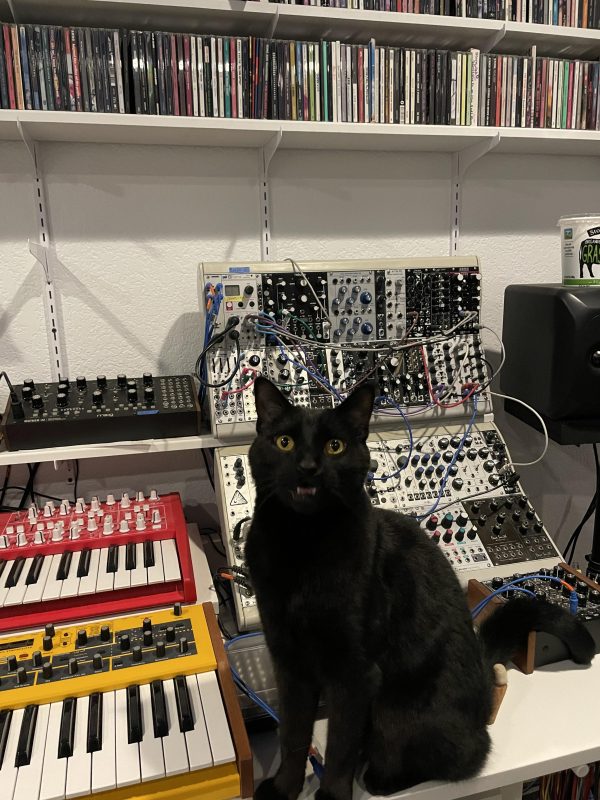
Sidney Crosby sings along with a modular setup, Dave Smith Mopho, Arturia Mini Brute, and a Moog Mother 32.
Submitted by @bittersweetdb via Mastodon.


Sidney Crosby sings along with a modular setup, Dave Smith Mopho, Arturia Mini Brute, and a Moog Mother 32.
Submitted by @bittersweetdb via Mastodon.
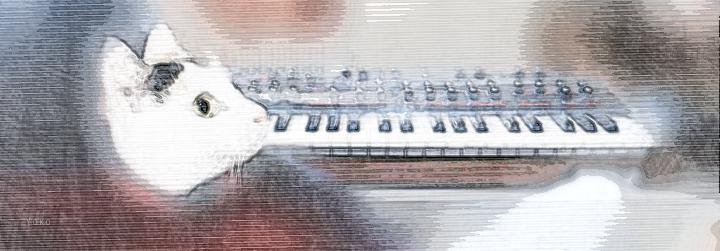
We start off the week with this lovely picture featuring one of the cats on Sawa Masaki’s Twitter and a DSI/Sequential Pro 2.
It is probably not a coincidence that earlier the same say, Sequential announced that they would be discontinuing the Pro 2.
The #DSIPro2 mono/4-voice paraphonic hybrid synth has officially been retired 👋 To get one while stock lasts, check with your local dealer: https://t.co/0XDpWLkwcM pic.twitter.com/bz68hZsBKl
— Sequential (@sequentialLLC) May 17, 2019
It’s been a busy season for Pitta of the Mind! We had three shows in the span of two months, beginning with our blue set at Pro Arts and culminating with ¡Voltage and Verse! at Adobe Books in San Francisco. You can get a taste for the show in our CatSynth TV video.
It was an honor to once again share a bill with ruth weiss. A Holocaust survivor and founding member of the San Francisco beat poet scene in the 1950s, she is still going strong, performing and supporting local institutions and artists.
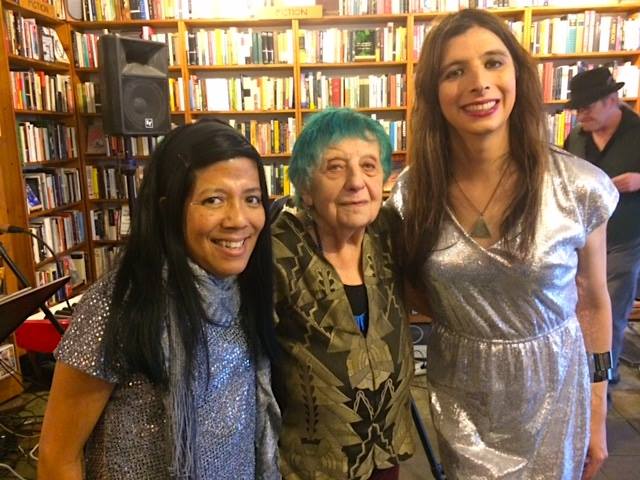
We were glad to see that she is continuing her collaboration with our friend and synthesizer virtuoso Doug Lynner. Together with log percussionist Hal Davis, they performed a set of poetry and music that simultaneously evoked earlier eras and the latest electronic experiments. Davis’ log drum provided an expressive metronome, undulating between a trot and a gallop. Lynner’s synthesizer lines filled in the spaces, sometimes with rhythmic appeggios and at other moments with long eerie drones. The synthesizer timbres and phrases complemented the words in multiple ways, sometimes underpinning the narrative in the manner of a good film score, at other times emphasizing the rhythm of the words and making them into a musical whole.
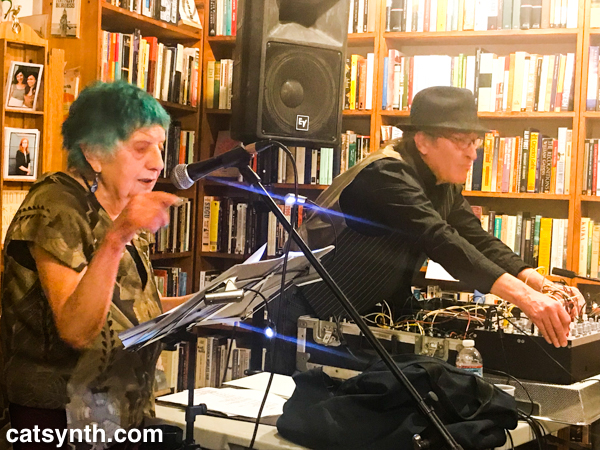
Our Pitta of the Mind set was part of a month-long celebration for the release of Maw Shein Win’s new book of poetry Invisible Gifts. The book is divided into four sections based on different colors. This works perfectly for our use of color themes in our performances. For this night, we chose silver and performed selections from the silver section of the book. There were some familiar poems that we have performed before, and some that were new to me. There were a variety of styles and subjects in the words that inspired different musical backings, from jazzy electric piano (my favorite) to abstract synthesizer explorations. I was able to reuse some of the modular patches I had developed for my recent show in Portland and make them work with the rhythm of the texts.
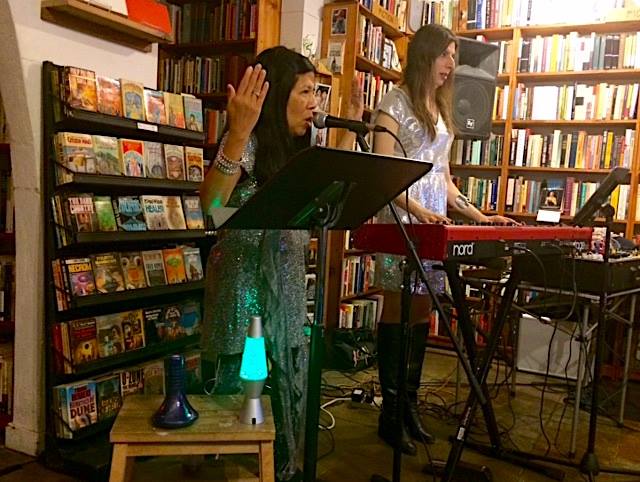
Maw and I have performed together so many times now that it has become almost second nature to realize a new set; our three shows this season went off (nearly) flawlessly, and have been among the best we have done in our nearly seven years of collaboration! We have developed a toolset and pallete of instruments (including the Nord Stage and Prophet 12) and sounds that we can quickly turn to with each new text, which makes the process of learning new pieces both simple and fun. I certainly hope we can keep up the momentum in the remainder of the year, even as I turn my own attention to other musical projects.
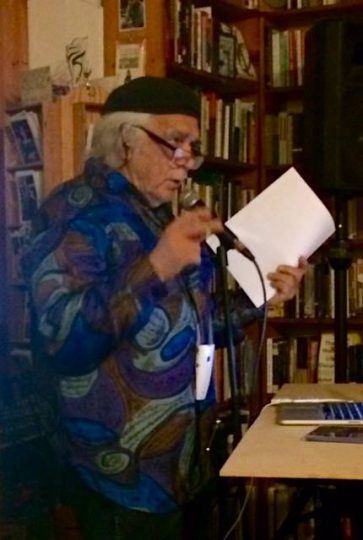
In between our set and weiss/Lynner/Davis, we were treated to a presentation by Ramon Sender. Sender was a co-founder (along Morton Subotnick and Pauline Oliveros) of the San Francisco Tape Music Center in the early 1960s, but on this evening he regaled us with stories of his time at the Morning Star and Wheeler ranches in Sonoma County in the late 1960s and early 1970s. Morningstar, founded by Lou Gottlieb, was a radical experiment in communal living, populated by an interesting cast of characters along with folks who “commuted” between San Francisco’s Haight-Ashbury district and the ranch west of Sebastopol. It only existed in its communal form for a short period of time before being shut down by Sonoma County. Sender and others then moved to the nearby property of artist Bill Wheeler, who followed Gottlieb’s lead and opened his ranch as a commune open to all. I found myself fascinated by Sender’s stories, and would love to learn more about the history of the area and these communal experiments.
It was a fun night of music and words that lived up to its billing, and I certainly hope to have a chance to perform with everyone again. And thanks to Benjamin Tinker and Adobe Books for hosting the event! Please support your local bookstores and performance spaces.
[Photos not marked “catsynth.com” in this article courtesy of Maw Shein Win.]
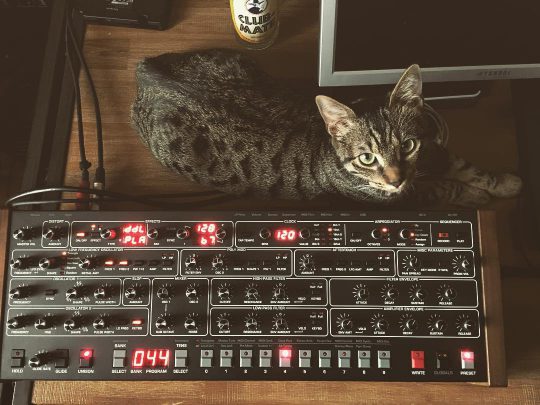
Cat showing off a Sequential Prophet 6. By maxeredussence on Instagram.
We at CatSynth are a bit envious of this kitty, as we covet the Prophet 6 (and the Rev 2). I love my Prophet 12, but these are completely different instruments and complement one another. You can read our NAMM 2015 review of the Prophet 6 here.
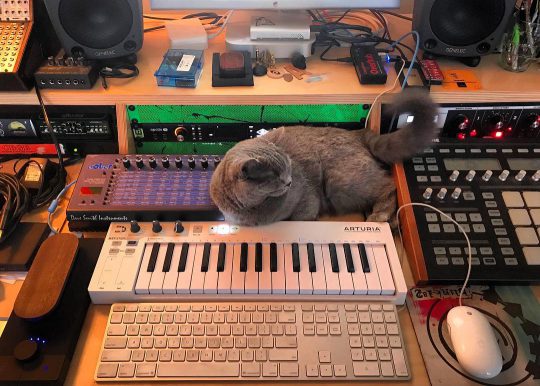
After a brief hiatus over the weekend, we’re back – more on that later. In the meantime, we have this cute photo of Zelda the Gray with a DSI Evolver, Arturia KeyStep, Native Instruments Maschine, and more 😺. From skaterdays on Instagram.
I have been busily preparing for tonight’s solo set at The Lab here in San Francisco. As usually happens, I initially plan to simplify the setup, but then as I work on the set musically, more instruments and equipment end up part of the rig. And this one may be one of the largest to date.

In addition to the Nord Stage (aka “The Big Red Keyboard”), there is the newly reconfigured modular synth, the Prophet 12, the Moog Mother 32, Casio SK-1, and iPad. The modular path features multiple voices, including some processing external audio from the Nord and the SK-1, respectively.

Why so big? Well, it comes out the current musical direction, which mixes jazz and funk with experimental electronics. That means a full-size keyboard is always present. And the electronics has to provide rhythmic and harmonic support in addition to timbral support. This always adds significant complexity, but provides for a richer musical experience.
Here are the details on the show, including the other acts. I am excited to have a group improv with my friends Joshua Marshall, Jaroba, and Christina Stanley. And the evening will begin with an orchestra of invented instruments from Pet The Tiger (David Samas, Tom Nunn et al.) with dance by Christina Braun. If you are in the Bay Area tonight, please consider joining us.
Thursday, June 22, 8PM
The Lab
2948 16th St SFA special evening of funky and noisy sounds, invented instruments, whimsy, and more 😺 🎶
8:00PM Pet The Tiger Inventors Collective performs Arc Weld
8:40PM Amanda Chaudhary solo. Funky and experimental electronics
9:20PM Amanda Chaudhary with collaborators Joshua Marshall, Jaroba, and Christina Stanleydoor: $5-10
Additional info on BayImproviser.
Edited to correct an “alternative fact” in one of our photos.
There were several new offerings at the Dave Smith Instruments booth this year. The most prominent was the new REV 2 polyphonic analog synthesizer.

The REV 2 is billed as a successor to the Prophet ’08, and features an architecture with two DCOs and two Curtis filters, along with numerous other features. It also has a built-in step sequencer. It plays very nicely and has a powerful sound, though perhaps not quite as “luscious” as the Prophet 12 that I regularly use in my own music. I expect the REV 2 will be quite popular.
Last year, DSI introduced the OB-6, a collaboration between Dave Smith and Tom Oberheim that features an Oberheim SEM sound engine. This year they have a tabletop module version of this instrument.

CORRECTION: This is a Prophet 6 tabletop, not an OB-6. There is, however an OB-6 tabletop module.
It has the same engine and a large array of front panel controls that make it a less expensive addition for someone who wanted the OB-6 synth but doesn’t need yet another keyboard.
Dave Smith also had another new collaboration, this time with Pioneer DJ. They introduced two new instruments: the TORAIZ SP-16 DJ workstation and the TORAIZ AS-1 mono synth.

The SP-16 is a sampler workstation with multiple voices and facilities for loops, triggers, and other features one expects from a beat-oriented tabletop synth, but also filters from the Sequential Prophet 6. THE AS-1 is purely a synth, featuring an architecture similar to a single voice of the Prophet 6. As such, the AS-1 is practical way to add the Prophet 6 sound to a larger setup.
As always, we look forward to seeing and hearing more of these new instruments from Dave Smith.